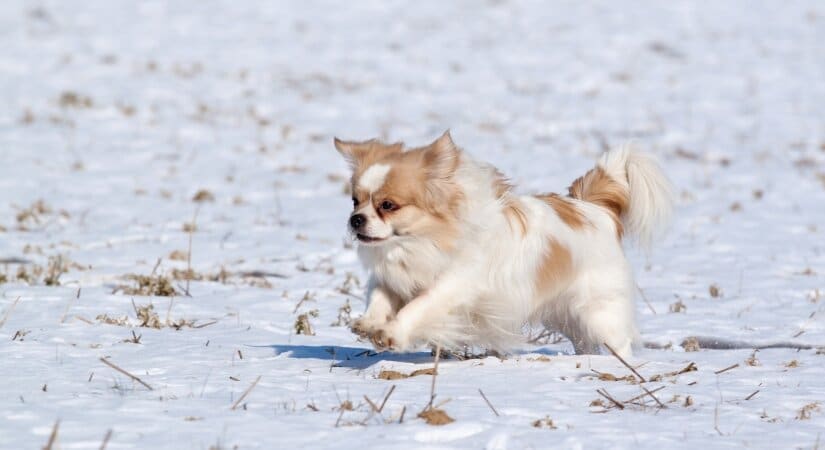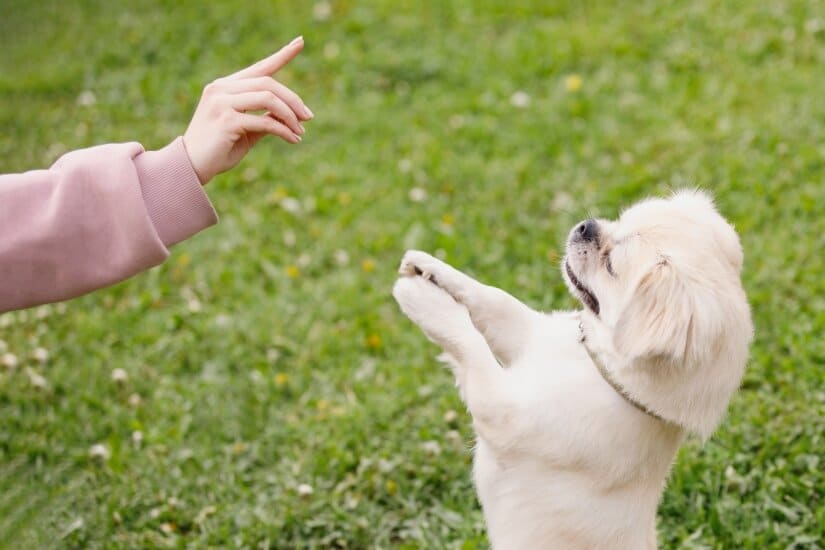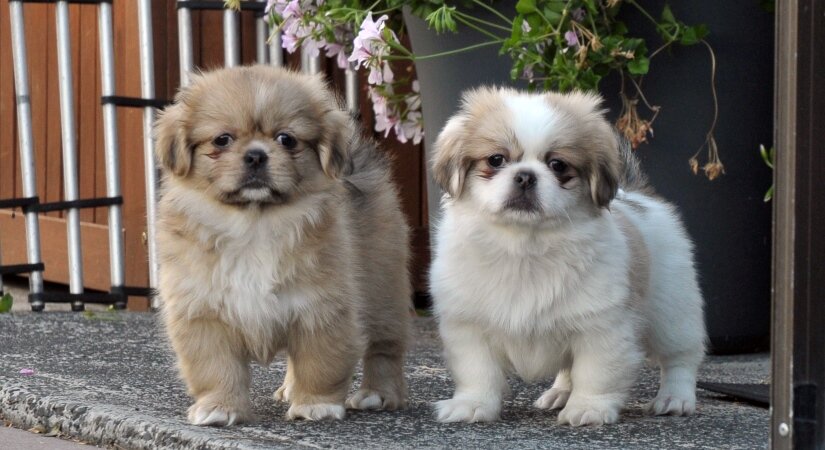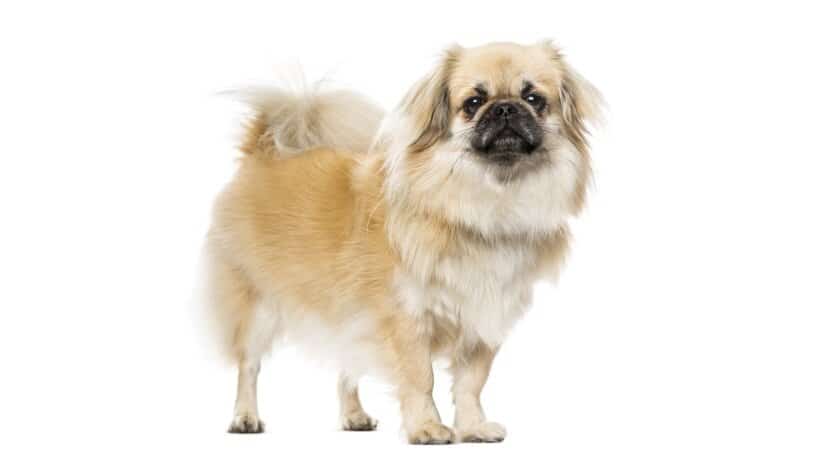



Non-Sporting
The Tibetan Spaniel comes from Tibet. The Tibetans did their best to preserve the Tibetan dog breeds. The nickname for this dog breed is “Tibbies.” They were companion dogs, and also used for guarding purposes. The Tibetan Spaniel worked together with their cousins, the Tibetan Mastiff. They used to sit on top of the monastery walls and survey the lands below.
Brief History
The Tibetan Spaniel is part of the UKC, Companion Dog Group, and the AKC, Non-Sporting Dog Group. This dog breed is not a Spaniel dog breed, but originates from the Pekinese and Japanese Chin bloodlines. Tibetan monks bred the Tibetan Spaniel to look like lions, or Fo dogs. This is treasured in Buddhist symbolism. The Tibetan Spaniel was gifted to rulers in other Buddhist countries. This dog breed was both companion and guard dog in monasteries. The Tibetan Spaniel arrived in the U.K during the late nineteenth century. It arrived in the U.S in 1965.
Physical Description

The Tibetan Spaniel is a small dog breed with a medium-sized muzzle. It is longer than it is tall. With a black nose, and medium sized, dark eyes, the Tibetan Spaniel has medium sized ears that are pendant. The feet are small, and are hare footed. The chin has depth, the tail is high, and carried curled. This is a double-coated dog breed with silky, medium length hair. The coat can be any color, with a mixture of colors allowed. There is also a ruff around the neck, and ears. Hind legs and rump are feathered. The Tibetan Spaniel has a smooth coat on the face and front of legs. This dog breed is alert and active. Movement is free and free-flowing. Temperament is happy and assertive.
Temperament
The Tibetan Spaniel is totally independent, and can sometimes be stubborn. This dog breed can be aloof with strangers. This regal dog breed does not do well with small children, or with other dogs. It’s best to socialize the Tibetan Spaniel during the first four weeks of puppyhood, so that this dog breed will make every effort to get along with other dogs, and people later on in life. That said, this breed does get on with people and other animals that it knows. This is a good tempered dog breed with family, and friends. It needs lots of affection and attention.
Positive dog training needs to start early since this dog breed is stubborn. This charming dog breed will form close bonds with his dog parent. The Tibetan Spaniel adores being pampered, and does enjoy visiting Starbucks for a Puppuchino. This dog breed makes for the perfect companion at restaurants, and on dog vacays! This is an eager-to please dog breed that has catlike tendencies.
Special Needs
The Tibetan Spaniel needs plenty of socialization, and positive training from puppyhood. This dog breed does best with daily exercise combined with mental stimulation. This dog breed loves taking part in canine sporting activity even though it is a small dog breed. This bred does well with apartment living. Daily grooming maintenance and care for this dog breed is necessary. The Tibetan Spaniel should not fly in cargo, but in cabin instead. Always consult with your veterinarian prior to flying with your dog.
Possible Health Concerns
The Tibetan Spaniel is an active and healthy dog breed that may be susceptible to the following health conditions:
- Progressive Retinal Atrophy (PRA) is another common hereditary eye disease in the Tibetan Spaniel. This is an expensive health issue, and early detection is critical to the well-being and vision of your dog. PRA can lead to blindness.
- Patella Luxation: This is where the groove in the knee joint is not deep enough to hold the patella in place, resulting in the patella slipping out on either side. This painful condition can be corrected with surgery.
- Cherry Eye. (Prolapsed Nictitans Gland) This is the inflammation of the Harderian gland, which is an accessory tear gland. This can result in dry eye. It is common in young dogs, and certain dog breeds like the Tibetan Spaniel. With this disorder, the gland of the nictitating membrane thickens and slips out of its proper place. When this disorder becomes severe, the red glandular mass swells and protrudes over the edge of the membrane, hence the name “cherry eye.” Consult with your veterinarian for advice.
Exercise

All dogs need exercise, some more so than others! The Tibetan Spaniel dog breed is one that does well with fun exercise schedules. This dog breed is happy hanging out at home and going for car rides. A relaxed walk around the block suffices. Dogs sports like agility is fun for most dog breeds. It is enjoyable for both handler and dog, and also reinforces the dog-pet parent bond. Elderly dogs can participate as well. Make sure to visit your veterinarian for a health check prior to beginning any vigorous sports with your dog.
Flyball is also another fun activity, and is a team sport that is social and invigorating for both dog and handler. Obedience trials are popular today with obedience training being the basic building block for your Tibetan Spaniel. The sooner positive puppy training begins, the sooner your dog understands and responds to what you’re asking him to do.
Regardless of whether you’re going to participate in fun canine sports with your Tibetan Spaniel, regular daily exercise is a must. Off-leash runs at the dog park or beach work wonders to get your pooch calm and focused. Combining that with positive training classes, and plenty of socialization which has to begin during the first four weeks of age, allows for your dog to be the best that he can be.
All positive dog training needs to be tailored around the sensitivity and intelligence of this stubborn and intelligent dog breed. The Tibetan Spaniel is also good at scent work, and some are certified as therapy dogs. They seem to enjoy working in nursing homes and hospitals.
Nutrition
A high-quality dog food is recommended for the Tibetan Spaniel. All dogs are different, and some dog food brands will be better suited for your dog. When it comes to dog foods, understanding your dog’s current health and nutritional needs is paramount.
There is no best diet since all dogs have different dietary needs, so it’s always smart to find the best dog food to match each individual dog. That said, consult with your veterinarian for advice when changing your dog’s diet. Consult with your veterinarian if your dog has a medical condition, or is pregnant or lactating.
Here’s what to look out for when choosing a dog food:
- Healthy ingredients
- Fresh meat
- Vegetables and fruit
- No controversial ingredients
- No added hormones and steroids
- No unnamed meat sources
- Right ratio of macronutrients
- By-products in dog food are fine when they are organ meats
- Dog food should not be overly processed
Basic ingredients should include whole meats, fruits or vegetables in their top five ingredients are considered good foods. Those that also add healthy antioxidants like blueberries, cranberries, pomegranates and pumpkin are ones to purchase! That said, organic, natural and preservative- free with no artificial ingredients, are also key to a well- balanced, and high quality dog food!
Keep in mind that pups need to be on a puppy food formula, and adult dogs on adult dog food formulas. Senior dogs also should be on a senior dog food formula. Beet pulp can also act as a stool hardener in pups, so opt for one without beet pulp if your Tibetan Spaniel has digestive issues.
Advantages of Dehydrated Dog Foods for Tibetan Spaniels That Enjoy Pet Vacays
- Minimally processed
- High moisture content
- Whole foods used
- Human grade ingredients
- Convenient to travel with
- Dehydration process leaves behind natural ingredients that support immunity and good health
- Stable shelf life
- Does not need refrigeration, so easy to travel with
- Color, flavor, vitamins, minerals and phytonutrients not impacted by dehydration process
Grooming
The Tibetan Spaniel requires minimal grooming because of its soft, smooth coat. This is a natural breed that just requires trimming on the feet hairs. That said, daily grooming is still necessary. Hair behind the ears need to be brushed regularly. Rear fringes need to be brushed and trimmed often. All dog breeds need to be groomed. A gentle hound glove makes for easier grooming, and helps to remove dead hair. This breed does shed, and can shed at any time of the year. If taken to a professional groomer, this dog breed should not have the hair between the legs or belly clipped.
Nails need to be trimmed regularly, and ears checked for infection, and cleaned. Nail trimming should start during puppyhood, so as to get the puppy used to being handled and groomed. Additionally, daily teeth brushing is a must for this loving and active dog breed. A focus on dental care is important. Smaller dog breeds tend to have more dental problems.
Adopting a Tibetan Spaniel

The Tibetan Spaniel is an incredibly popular dog breed, most especially among apartment owners in big cities. That said, be sure to be prepared when bringing your adopted dog home. For all their talents, the Tibetan Spaniel may be a barker at times, and does not enjoy being left home alone.
With their feisty, affectionate personalities, they are more likely to try and escape out the front door or by the backyard if left alone for long periods of time, most especially during the first few months after being adopted. This breed adapts easily to new home environments, but definitely needs a calm environment and plenty of attention. Finding the right Tibetan Spaniel for you and your family will be easy. Keeping your pooch, happy and healthy must be a priority. This very playful dog breed that is curious by nature and incredibly fun to have around, deserves the very best!
In addition, make sure that you have the financial resources and time for your Tibetan Spaniel. This is a lifetime addition to your home!

Tibbi’s are often found at Pekingese rescues. They are very similar. Beware though because a Pek or Tibbi not socialized is a challenge. I know I have one. Love her but she is harder to manage than my socialized Pek the same age.
Thank you for sharing your experience with Tibetan Spaniels and Pekingese! It’s interesting to hear how they can often be found in similar rescue situations due to their similarities. You bring up an important point about the challenge of managing pets that haven’t been socialized properly. Socialization is indeed crucial for ensuring a well-adjusted pet that can interact confidently with both humans and other animals. For those facing similar challenges, patience and consistent training are key. Positive reinforcement techniques, such as treats and praises, can be particularly effective. Additionally, considering professional training or behavioral consultation might provide personalized strategies to manage specific issues. It’s wonderful to hear about your commitment to your pets, and sharing such insights helps others understand the importance of early socialization. Keep up the great work!